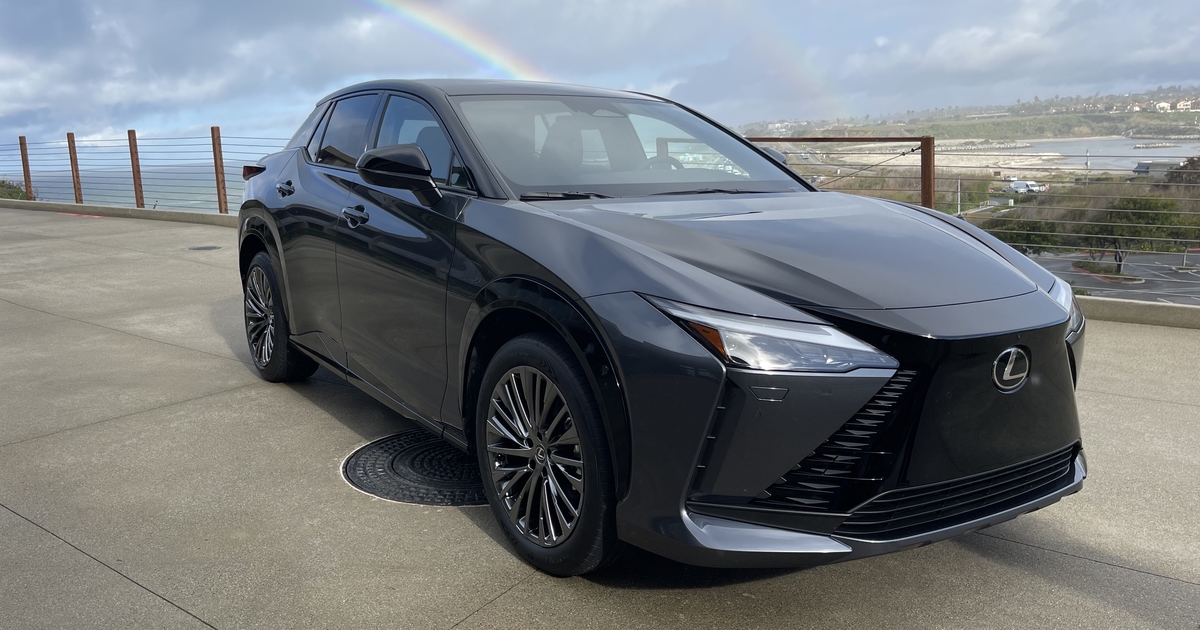
Lexus’ new 2023 RZ 450e electric crossover will offer luxury EV shoppers a fresh alternative to Tesla’s Model Y in an elegant and athletic package that starts just under $60,000 and can travel up to 220 miles on a single charge.
The compact crossover, which is on sale now, has distinctively Lexus exterior styling and carries forward the spindle grille, which the automaker calls the spindle body.
“Depending on whether it’s a battery-electric vehicle, plug-in or hybrid, there will be different iterations of the design, but it will all be reminiscent of this spindle body approach versus just being stuck to the spindle grille,” said Eli Nesbitt, a Lexus senior analyst and product expert.
The goal, Nesbitt said, is to maintain Lexus styling without intruding on aerodynamics. Because of the low roofline and a front fascia engineered for precise air intake, the RZ has a drag coefficient of .29 and is the most aerodynamic vehicle in Lexus’ lineup, he said.
The steeply sloped rear of the RZ is edged by two roof rail-like lines that extend past the body into a point that Lexus calls “vortex generators.”
“They serve a lot of purposes from a design standpoint as well as a function,” Nesbitt said.
From the side, the vortex generators look like a wing, but they are not connected. Their design is intended to improve straight-line aerodynamics and increase side wind stability. They also funnel high-speed air down the center of the rear windshield so water is cleared from the glass.
Two well-equipped trims — Premium and Luxury — brim with tech and ingenuity centered around driver comfort and usability.
Both trims are configured in an all-wheel-drive setup with a 150-kilowatt motor in the front and an 80-kW counterpart in the back powered by a 71.4-kilowatt-hour battery pack. Combined output is 308 hp; the front motor has 196.4 pound-feet of torque and the rear has 124.3.
The Premium trim can be equipped with either 18- or 20-inch wheels, and the Luxury is only offered with the larger option. Owners that want sleeker, sportier styling on the RZ will sacrifice style for utility — the larger set of wheels drops the RZ’s range from 220 miles to 196.
When hooked up to a Level 3 DC Fast Charger, the RZ will recoup 80 percent of its battery life in about 30 minutes. Using a 240-volt Level 2 charger, the battery will take about nine and a half hours to recharge.
All RZs have a panoramic glass roof that feature an electric current to toggle between opaque and clear. The shadeless panel design gives passengers more headspace and prevents it from heating up. It also blocks UV rays even when in the translucent setting.
Though the RZ does not have a frunk, the rear cargo area is functional and smart. The rear door offers a “lock and walk” function, which allows the user to hit the lower and lock button before grabbing cargo from the trunk; as soon as the RZ senses they’ve moved three meters away from the car, it will close and lock itself.
Future iterations of the RZ will employ a steer-by-wire system that enables electronic exchange of steering and road surface information between the wheels and the control, a yoke-style steering wheel. The steering system constantly adjusts to the RZ’s speed, which allows agility in slow-speed scenarios and stability while traveling at high speeds. The yoke only requires a slight adjustment while turning or pulling into a parking spot, vs. a full spin in a mechanical set up.
Tesla offers an optional steering yoke on the Model S and X but does not employ the same electronic steering. That means the driver must spin the yoke the same way they would a traditional wheel.
The flat-topped shape of the yoke on the Lexus RZ gives the driver a clearer vantage point, and the flat bottom of the wheel allows easier entry and exit. Lexus said the yoke and drive-by-wire system will also provide an easier leap to Level 3 driving, which transfers control of the car from the driver to the car.
Lexus did not provide pricing for the steer-by-wire system, only that it would be available on the Luxury trim in the next model year.
The RZ electric crossover will be built at Toyota’s Motomachi assembly plant on the same line as both the Toyota bZ4X and Subaru Solterra EVs.
Volume for the RZ is capped at 4,900 for the 2023 model year.